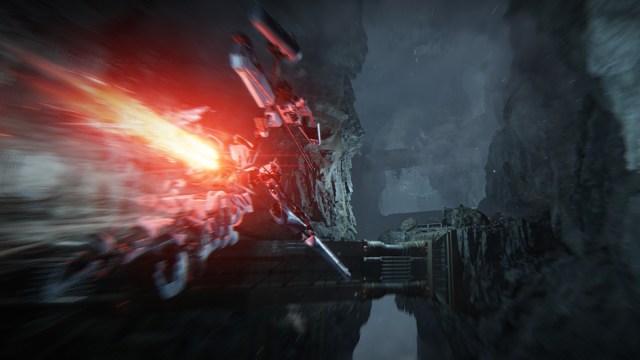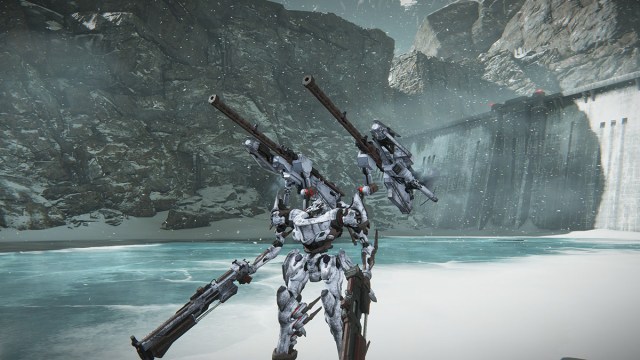To say Armored Core 6 is a triumphant return for the greatest mech game franchise ever is an understatement. It’s the culmination of years of development on the series and all the lessons learned from the last 10 years of the Soulsborne genre. AC6 is the ultimate compromise between the clunky, heavy games of the series’ beginnings and the neck-snappingly fast gameplay of later titles. Add in some of the toughest bosses FromSoftware has ever made, absolutely killer performance, and the best Armored Core story ever told, and you’ve got one of the best games of 2023.
Armored Core VI: Fires of Rubicon Review — A New Flame

Armored Core 6 eschews the frankly absurd speed of AC4 and For Answer. However, it’s also much faster than any of the classic titles. You have tons of mobility without it being jarring, and it still feels like you’re moving around in a 30-foot-tall mass of steel. It’s fluid and weight without being overly restrictive. Overall, every action is incredibly satisfying to pull off.
My initial estimation was not, however, that I immediately understood all I was able to do. My several deaths to the first boss due to flubbing the controls are proof of that. Even so, the ease of grasping the core mechanics while seeing the potential for far greater things was refreshing.
Using the weapons in Armored Core 6 is also a treat. Somehow, almost all of them feel unique, powerful, and amazing to shoot. The starting kit is also one of the best setups you can run early in the game. It’s relatively fast, with good chase-down and damage output. Sure, you can do some more optimization to it. Adding a better-performing primary, some extra rockets, and swapping out a few body parts for more speed or survivability is never a bad call. But as your starting class, it’s surprisingly effective. I took down Balteus with a build that wasn’t far from the starting one. But that was only because I’m stubborn and wouldn’t update my setup.
That’s not saying the game is perfectly balanced. It’s not, especially in PvE. About two-thirds through the campaign, you get access to two weapons that crack the story content wide open. The dual Zimmerman shotguns and dual Stun Needle Launchers are OP. This loadout essentially trivializes the entire game. I can count on one hand the number of missions where that setup doesn’t obliterate everything in sight.
It’s a testament to the combat design that using this broken setup is still too much fun. I was a bit disappointed in how even the final boss of each playthrough could do almost nothing about the Zimmerman/Stun Needle combo. Though, there are plenty of other weapons I can use now that I have access to the entire game.
A New Level of Level Design — With Story, Too

The Armored Core series has never been known for its stellar level design or storytelling. I can say unequivocally that Armored Core 6 changes one of those things. Where previous games were either massive open spaces or labyrinthine collections of tunnels and rooms, AC6 showcases one aspect that’s made FromSoftware levels famous: verticality.
It’s amazing how much removing the roof does for the moment-to-moment gameplay. That and taking the Dark Souls layered level design philosophy to all the internal areas. Every level in Armored Core 6 is enormous. Even the smallest being several kilometers wide and just as many tall.
There’s also a fair bit of FromSoft trickery on display. There are traps, ambushes, and plenty of hidden enemies and treasures scattered about each massive level. The level of mastery you can reach in just one of the game’s missions will make AC6 a speedrunner’s dream. Challenge runs will be just as much, if not more, fun than simply going fast.
Unfortunately, while Armored Core 6 elevates the series’ narrative with more interesting characters, a few twists, and some stronger moments, it’s not award-winning. There are plenty of classic sci-fi tropes on display. The MacGuffin material called Coral. Human augmentation. Massive corporations wanting the absolute worst for everyone but themselves. The list goes on.
Sad, too, is that the Soulsborne “unexplained bits make the story richer” philosophy falls a bit flat. In a game like this, being a bit more straightforward would have been helpful, even if you have to hunt for the answers in classic Souls fashion. I don’t want the full story of the Fires of Ibis delivered in exposition. Despite that, exposition is this game’s weakest part. Much of the story is told to you in audio logs between missions or over the radio during them. As much as you take part in the events of Armored Core 6‘s story, the actions you take boil down to “blow this up” or “destroy that mech.”
The only big narrative moments come during and after the setpiece boss fights. Even then, you’re mostly told what’s going on rather than seeing it yourself. That there are so-called “Decision Missions” that alter how your playthrough’s story unfolds is a nice touch. Indeed, it adds a bit of agency to a game without much of it. But you could make the argument that “lack of agency” is a story beat in its own right. In that, I’d agree. However, it’s not as satisfying to pay off as it could be.
The game’s pacing is also a bit uneven, with the flow of big story missions and the short “just blow this up, you gun monkey” missions being too skewed toward the latter. I understand why the smaller experiences exist. But when you’re suddenly thrown from something that takes two minutes into a 20-minute slog with a massive boss fight at its end, it can be jarring, to say the least.
The Bosses of Bosses

The boss fights in Armored Core 6 are some of its highlights, with massive scale, even more difficulty, and some of the biggest payoffs in all of gaming. They can also be very frustrating if you don’t have the parts to beat them. Worse, you won’t have the dual Zimmermans and Stun Needle Launchers during the early parts of your first playthrough, which can make fights against the likes of Balteus and the Sea Spider exercises in frustration.
Those tough fights are meant to be walls, however, and force you to rethink everything about your build. The game gives you all the tools to completely obliterate every challenge in front of you. You just have to have the wherewithal to know when you’re beaten and come back with something different. Things aren’t quite as bad as in Sekiro, where running up against a wall is usually a “get good” moment and not much else. There are few ways to increase your weapon’s damage and usability, meaning while you still need to learn the game and the fights, you still have tons of build options to try out before skill becomes the limiting factor.
Some of the bosses are, however, more annoying than they are fun. Balteus is a great example, with its never-ending barrage of missiles and constant shield. Some of the later game fights also add attacks that can almost one-shot you, making learning opportunities scarce. Worse, these attacks tend to come in the second phase of the boss fight, meaning you have to push through half of the boss’s health bar to even see and die to them. There were some fights that echoed Malenia’s Waterfowl Dance from Elden Ring with their sense of “how do I deal with that?”
Other Nuts and Bolts

The other aspects of Armored Core 6, like its music, UX, UI, and performance are something of a mixed bag. I’ve listened to the AC6 soundtrack in isolation from the gameplay, and I like it, but I would have preferred to hear more of it as I was playing. The Armored Core series has some great tracks filled with flair and flavor, and I wish I’d been able to experience some of AC6‘s in the moment.
Navigating the game’s menus can be frustrating, to put it mildly. I was playing on mouse and keyboard, and keeping the item I wanted to select chosen was a nightmare. There are other in-game features that make the menus even more of a hassle to operate. And for as much effort as the game goes through to allow you to customize your mech, there’s no way to view it in full profile. You’re stuck looking at it during cutscenes, at the start of a PvP match, and in partial view in the Assembly menu.
Lest we end on a sour note, the game runs like a dream. I was easily able to hit and maintain 120 FPS at High-Ultra settings on my 3080 and 13700K at ultrawide resolution — with a stream and other apps running in the background. Hell, I can make the game run at a solid 60 FPS on Steam Deck by tweaking the settings down. That Elden Ring and the entire Souls series runs on a version of the Armored Core 6 engine is nothing short of a miracle in comparison.
Armored Core 6 Review — The Bottom Line

Pros
- Amazing gameplay, boss fights, performance, customization, and so much more.
- A vast improvement in level design over previous entries, with a better-told story.
- One of the most fulfilling gameplay loops on the market.
Cons
- Frustratingly difficult in some places.
- Uneven pacing from both a mission and story design perspective.
- Some interface and user experience hiccups.
If you’re looking for a fast-paced, highly customizable, punishing but fun mech action game, there’s no other game on the market I can recommend more than Armored Core 6. Its few foibles are easy enough for me to forgive, and if you can break through some of its early walls, I guarantee you will find a magical experience unlike anything else on the market right now.
[Note: The writer purchased the copy of Armored Core 6 used for this review.]







Published: Sep 7, 2023 03:02 pm